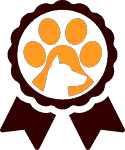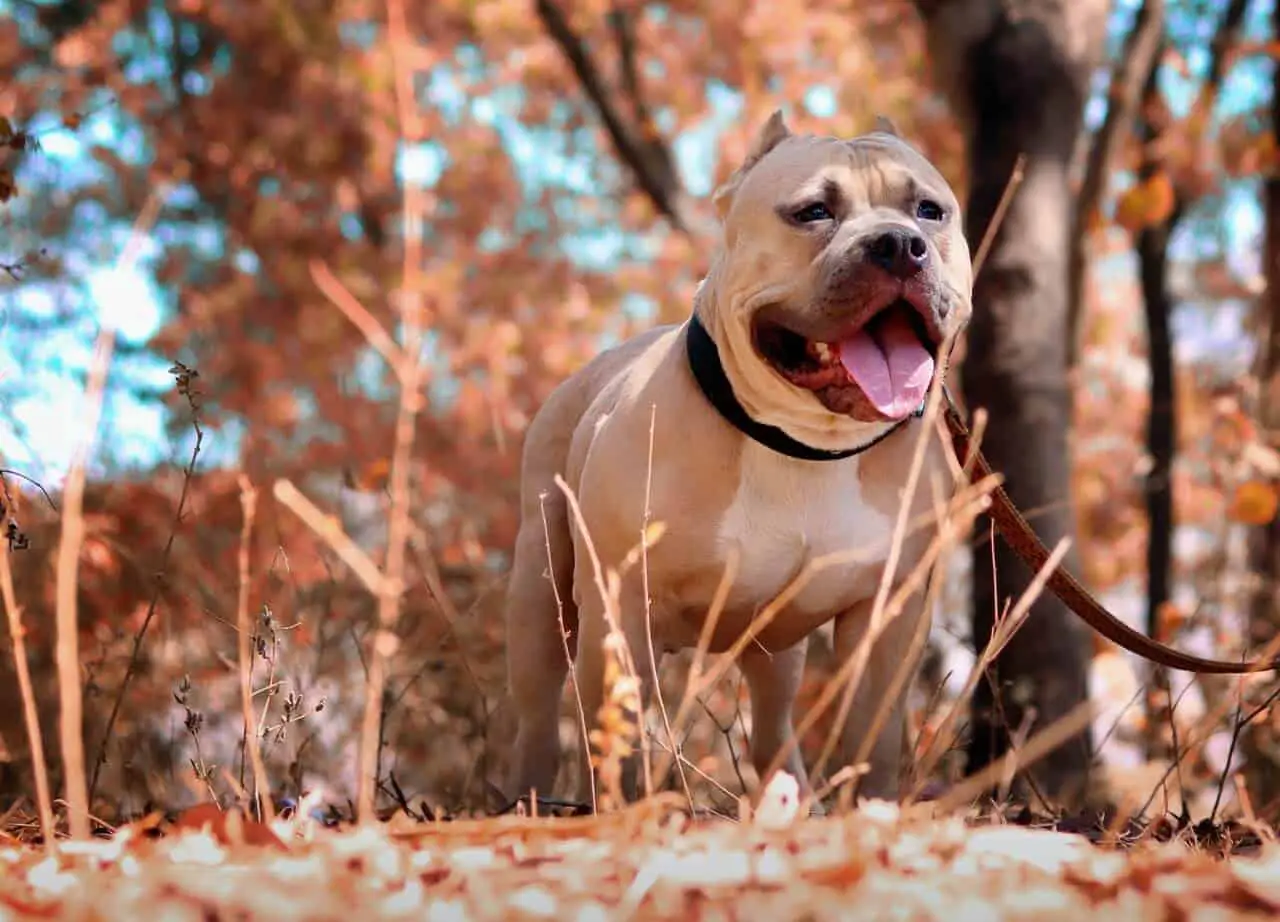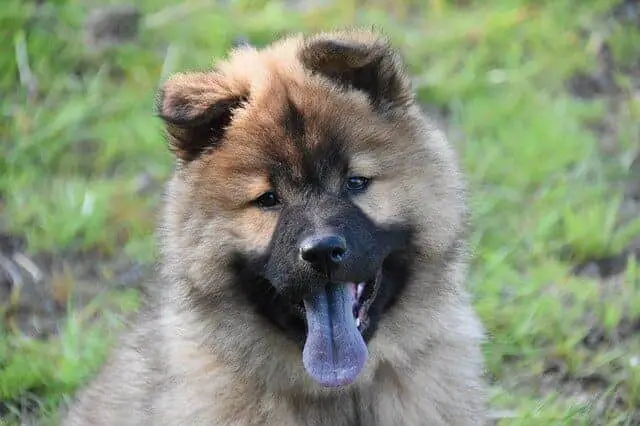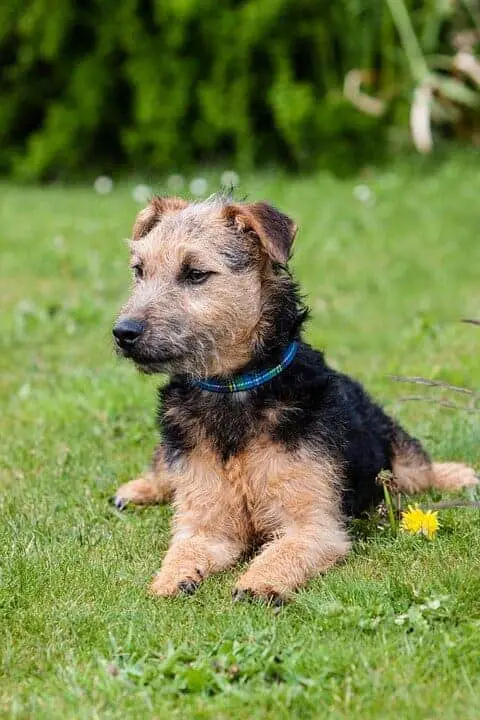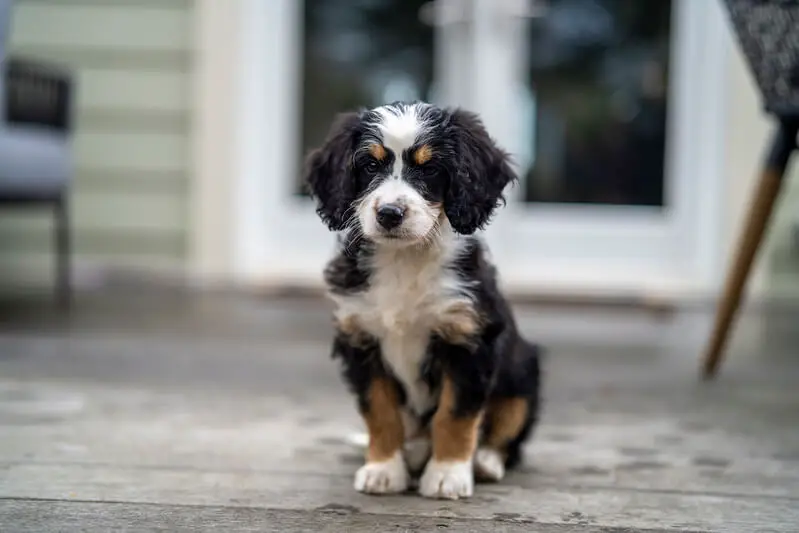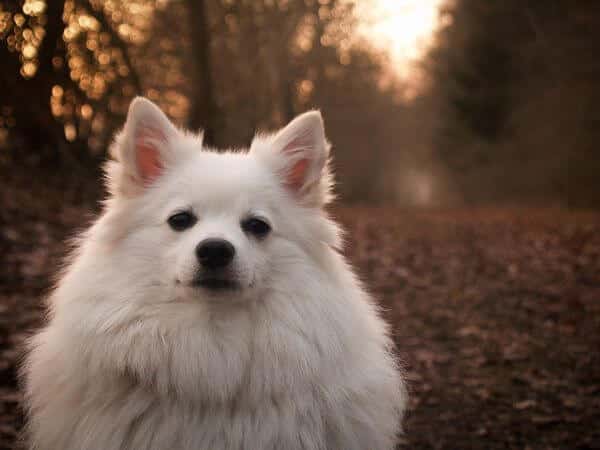The Chow Chow (or Chow for short) is an impressive dog with a compact build. Often suspicious of strangers, Chows are forever loyal to those they love. They have no special need for exercise. Chows that are well-trained and socialized usually carry an air of dignity. They have either rough or smooth coats colored cinnamon/fawn, red, black, cream, or blue.
According to Chow Chow breed standards, dogs with multicolored coats are believed to be outside the norm. Even some of the five colors we mentioned are not recognized in some countries as standard coat color in Chows.
Typically, Chows have deep-set and almond-shaped eyes and their unique blue-black tongue sets them apart from every other breed except Shar-Pei. They have very straight hind legs unlike other breeds such as German Shepherd, giving them a rather stilted gait.
Chows are likened to cats because of their fastidious nature, making them come off as totally independent. Though they look so much like teddy bears, they are not a fan of cuddling.
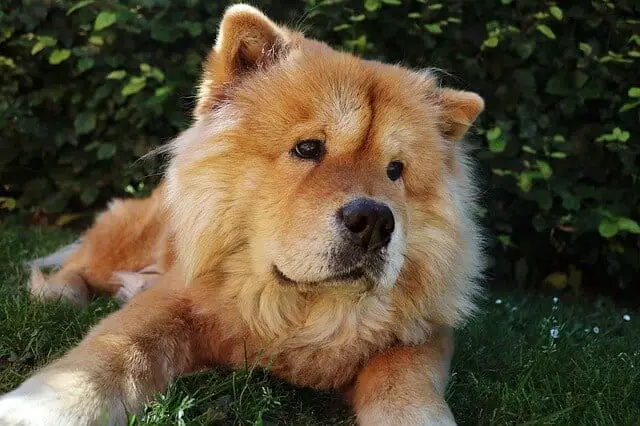
Chow Chow Key Information
Height: 17 – 22 inches
Weight: 40 – 70 pounds
Life span: 9 to 15 years
Breed family: Non-Sporting Group (AKC)
Exercise requirements: Low
Good with children: Mostly (if well socialized early on)
Area of origin: Asia
Also Known As: Black-tongue dog (her shi-you), Bear dog (Xiang gou), Wolf dog (lang gou), Puffy lion-dog, and Canton dog (Guangdong gou).
History
As a breed that is arguably the oldest in the world, most people believe that the Chow has been in existence for between 2000 and 3000 years, first being identified as a separate breed during the time that the Han Dynasty ruled China. This supports the general claim that Chows have their origin from Central Asia. Artifacts of China’s Han Dynasty (c. 206 b.c.) places them in the region during that period, but other evidence suggests that Chows have been in existence for much longer and they are progenitors of other breeds of spitz types such as the Norwegian Elkhound, Pomeranian, Samoyed, German Spitz and Keeshond.
In their long existence, Chows have been used for many purposes. At some point in time, they served as gracious buddies to Chinese royalty. It was recorded that an emperor of the Tang Dynasty, circa eighth century, owned a kennel facility that catered for some 5,000 Chows looked after by a permanent staff of 10,000 employees. Over hundreds of years, however, Chows also served as protectors, hunters, and sled pullers.
The recent discovery of a bas-relief dating back to the period when the Han Dynasty rule China (150-200 BC) shows that the Chow was a hunting dog at that time in China.
Personality
If you are looking for a great guard dog, the Chow is a good fit. They are sturdily built dogs with broad skulls and small ears that are triangular and erect with rounded tips. Chows are highly territorial and they show it in their display of great caution towards strangers.
Chow Chows don’t do well in frequent close contact with their owners, especially when they are not well socialized. If you want your Chow Chow to be calm and loving as an adult, you must train him or her extensively as a puppy, allowing decent interactions with other dogs, new people, and situations.
Chows exhibit a combination of personalities: the attractive look of a teddy bear, the superiority of a lion, the grace and self-reliance of a cat, and the allegiance and protective nature of a dog. The dignified and self-reliant nature of Chow Chows makes it befitting that they were once catered for in imperial Chinese kennels. A Chow will have no problem with a stranger after a proper introduction by one of his owners. I will leave you to imagine what a good intro looks like.
Interaction with Children
It is best to supervise the interactions between children and Chows. They do well when you raise them with children. However, they are not the type of dogs that enjoy cuddling and they will not tolerate abuse from a young child. The best family setting for Chows is that of older children where adults know how to treat them.
Teach your children how to make contact with your Chow, and monitor all interactions between both parties.
Interaction with other pets
Chow Chows are often able to relate well with other dogs and cats if you socialize and train them, especially when you introduce other dogs while they are puppies. However, it is observed that they put on their best behavior when interacting with dogs of the opposite sex, and I think you can guess why.
Feeding
Chows do well with high-quality commercial dry and wet dog foods. However, watch out for allergic reactions, especially on the skin of your dog. Some owners like to go with a low-grain diet. Dog treats should be used sparingly both as there is a risk that your Chow Chow will have an allergic reaction and also that excessive treats will cause them to put on weight.
It is recommended that you feed twice a day and give a total of two to three cups of high-quality dog food.
Avoid serving left-overs from your table and if you have to give table scraps, make sure to remove the bones. That can pose a great threat to the health of your Chow or any other dog. You also don’t want to feed your dog with human foods high in fat content. It is best for you to read up about what human foods your dog can and can’t have, doing this will help to prevent your dog from becoming unwell due to what you’re feeding them. As always, if you have any doubt make sure to speak to a qualified vet to ensure you’re doing the best for your Chow.
Food Allergies
Some Chows have been known to have allergies to common grains that are included in commercial dog foods. It is therefore advisable to ensure that you’re feeding your Chow a high-quality dog food that is low in grain. Speak to your vet about how best to check if your Chow is sensitive to grain in their diet.
Care
Chow Chows can adapt to various living spaces. However, it is better for their health if they live indoors with their owners, not in a kennel. They don’t do well with heat, so you would want to keep them indoors when it is hot outside.
Grooming
As you can imagine for a breed with coats as luxurious as that of the Chow, their coat’s require more attention than the average dog’s to maintain. Both the smooth and rough-coated adult Chows have a thick double coat that requires regular grooming.
Matting of the Chow’s coat can be a particular problem. Chow puppies have soft coats that mat easily with this becoming less of a problem as they grow older, though the coat around the head of adults remain prone to this. If your Chow’s coat does get matted then you need to ensure that you remove all matted hair and comb through the undercoat thoroughly.
The most effective way to prevent their coats from matting is to thoroughly brush their coat at least twice every week and bathe them monthly to keep their coat and skin healthy. Do not be tempted to bathe them too often as this will remove the natural oils for their skin and coat. Fortunately, Chows have very little doggie smell. If your dog has parasite issues like fleas or ticks, make sure to treat it immediately. Your grooming plan should include checking the eyes and ears of your Chow to check for any signs of infestation. After a bath, use a cool air dryer to dry your dog.
Given the huge amount of fur Chows have you’ll be unsurprised to know that they are heavy shedders, shedding their coat during spring and autumn seasonally.
One thing that will make your grooming time less stressful for you and your Chow is using the right materials. Some good tools to consider for brushing are medium pin brush for the longer body coat, stainless steel Greyhound comb with medium-coarse teeth, and medium-size slicker brush for the legs. You may also get a spray bottle of diluted coat conditioner to keep the coat moist as you brush.
You also want to mind the dental hygiene of your Chow in addition to nail care. Add all these to your grooming schedule to prevent the buildup of tartar and bacteria.
Nails
Nail care is an essential part of your Chow’s grooming routine. However, you should only be trimming their nails once or twice a month. Cutting your Chow’s nails too short can be painful for your dog which will make providing your Chow with the necessary grooming more difficult in future.
The easiest way to know when it is time for you to trim your Chow’s nails is when you can hear the nails clicking on hard surfaces like a tiled floor. This is an indication that they’re now ready to be trimmed.
If you’re unsure how best to trim your dog’s nails then it is worth asking your vet to show you how to do this properly. Failure to cut your dog’s nails properly can be painful and can open your dog up to infections, which we obviously wish to avoid.
It is best to start grooming your Chow as a puppy so they will get used to it. Dogs are quite sensitive when it comes to their legs. Hold your puppy’s paws frequently and look inside his mouth and ears. When you make grooming a positive experience, you are laying the groundwork for stress-free vet exams for when they becomes an adult.
Exercise
Exercise is an important part of keeping any dog healthy. It helps to keep them happy and avoid them becoming overweight, which would lead to other health issues. Chow Chows require quite a minimal amount of exercise compared with other dog breeds. Taking them for a couple 15-20 minute walks a day is adequate for keeping them healthy. You should also try to take time to play games with them, this will not only act as exercise but help with bonding between you and your furry pal.
Do keep in mind when you’re exercising your Chow that due to the thick coats they have they will start to overheat quickly. It is therefore advisable to limit the exercise that your Chow does on hot days, focusing on ensuring they can exercise during the cooler parts of the day.
Training
Training can be a stressful experience if it is not done right. Chows need to be socialized early with puppy training classes if you want them to be well-behaved as adults. To be successful in training, you need to patiently and consistently reinforce the training using positive words and actions. Chows are intelligent dogs but they can also be stubborn. Avoid using harsh methods for training to build a trusting relationship, we always feel that training through positive reinforcement is a far better way to train your dog than through other approaches.
Housing
Apartments
Chows are perfectly happy living indoors in apartments, though you may want to consider whether your apartment is suitable for a Chow. When fully grown they are large dogs, in smaller apartments this can be troublesome with them knocking into furniture.
One problem that many people experience with having Chows in apartments is that Chows are incredibly protective over their owner. This means that when house training your Chow, if you take them outside they may become pre-occupied by other people around, that your Chow perceives to be a threat. As they feel there are threats around they may not be willing to do their business, which means they may go when they get back to the apartment and feel they can relax.
One of the common misconceptions that people have about large dogs is that they are going to be aggressive. While you may know that your Chow isn’t aggressive your neighbors or building managers may not think that is the case.
Dog Houses / Kennels
As I stated earlier, Chows don’t do well with hot environments, and that is expected considering the thickness of their coat. As a result, they are not suited for kennels/dog houses mostly because these houses are usually constructed outside the home as a permanent housing space, exposing your dog to the temperatures in the environment.
Leaving them alone
Adult Chows are okay with being left alone in the house to do what interests them. They are used to having little contact with people and other dogs and they enjoy it. While they are okay with being left alone, if you’re going to be out all day every day then you should consider whether you’re in a position to own a dog, unless you can get someone who can check in on the Chow throughout the day.
While adult Chows are fine to be left alone, it’s not recommended that the same is done for Chow puppies. While they’re young this is the time when you should be making sure that they are going to grow up into a well behaved Chow who you can trust to leave alone. This is something you need to be around for.
Health
As it is with every other dog, Chows have health issues that are related to the breed such as hip and elbow dysplasia, eyelid entropion, thyroid function, patellar luxation and allergies. You can reduce the rate at which these health issues occur in your Chow by ensuring that you perform a thorough health screening when breeding or looking to buy a puppy. Register your puppy with a good veterinary service near you and keep your appointments with the veterinarian.
Your vet may recommend that you get some test done on your Chow check their general health and to check for the likelihood that they will develop a condition later in life.
Older age
Throughout your Chow’s life it is important to ensure they’re getting appropriate care from a qualified vet. This helps to catch issues early and resolve them. This still continues to be important in dogs as they get older as issues are more likely to arise and become problematic quickly if not dealt with.
As Chows get older it is important to keep up their regular exercise as much as possible. As they get older their metabolism slows down so they are prone to putting on weight. Going outside for exercise gives them a change to get some fresh air.
If your Chow reaches an age where they are no longer able to walk or are only able to walk for a short while then it may be worth thinking about a dog stroller to allow your Chow to still get fresh air and if they start to get tired you’re able to get them home easily. Chows are not the sort of dog that you can easily carry.
Allergies
Generally, Chow Chows have more allergies than any other breed, but sensitivity to allergens vary between individual dogs. Symptoms typically appear on the skin as we discussed earlier.
The common ones include flea bites, pollen, cat dander, and even dust. Some Chows are allergic to grains such as corn and wheat, a common ingredient in commercial dry food.
According to Drs. Smith and Foster, inhalant dermatitis (atopy) is the second most common cause of allergies in dogs, next only to flea-bite allergies. Atopy describes allergic reactions to substances that are inhaled, like dust, pollen, or mold.
Chow Chows often have skin allergy “atopy” that occur as a result of pollen, mold, or dust which makes us humans sneeze. Rather than sneezing, their skin itches.
The parts of the body usually affected include the belly, folds of the skin, ears, and feet. The most common signs are rubbing the face, licking of the paws, and frequent ear infections. Generally, these symptoms start between one year and three years of age, and it may get worse year after year. Fortunately, there are various options for treatment, your vet will be able to recommend a suitable option for treatment.
Wrapping up
Owning a Chow means owning one of the oldest breeds of dogs in the world. That is something that most dog lovers will be happy to experience and you are lucky if you own one.
Chow’s can make great pets for anyone who is willing to put in the time and care to look after them. If you look after them and treat them well then you’ll have their unconditional love.
We have tried to ensure that the information on this page is as accurate as possible. If you see any mistakes please let us know through our Contact Us page.
Found this useful? Share it with your friends
Share on facebook
Facebook
Share on twitter
Twitter
Share on whatsapp
WhatsApp
Share on pinterest
Pinterest
Share on reddit
Reddit
Share on email
Email

